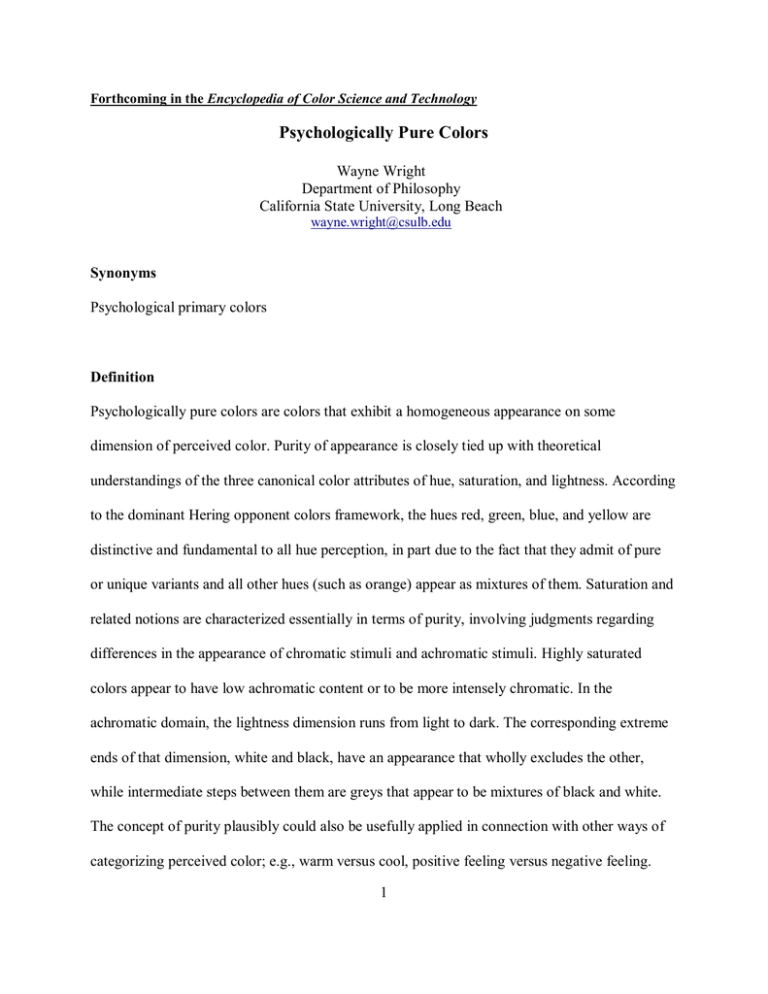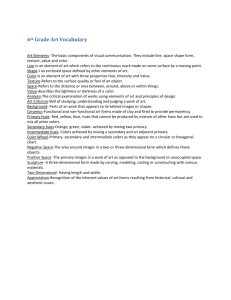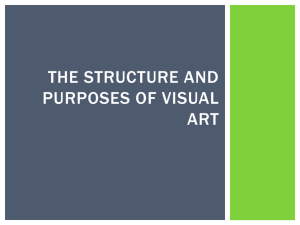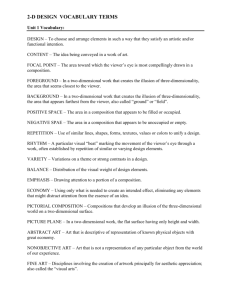Psychologically Pure Colors
advertisement

Forthcoming in the Encyclopedia of Color Science and Technology Psychologically Pure Colors Wayne Wright Department of Philosophy California State University, Long Beach wayne.wright@csulb.edu Synonyms Psychological primary colors Definition Psychologically pure colors are colors that exhibit a homogeneous appearance on some dimension of perceived color. Purity of appearance is closely tied up with theoretical understandings of the three canonical color attributes of hue, saturation, and lightness. According to the dominant Hering opponent colors framework, the hues red, green, blue, and yellow are distinctive and fundamental to all hue perception, in part due to the fact that they admit of pure or unique variants and all other hues (such as orange) appear as mixtures of them. Saturation and related notions are characterized essentially in terms of purity, involving judgments regarding differences in the appearance of chromatic stimuli and achromatic stimuli. Highly saturated colors appear to have low achromatic content or to be more intensely chromatic. In the achromatic domain, the lightness dimension runs from light to dark. The corresponding extreme ends of that dimension, white and black, have an appearance that wholly excludes the other, while intermediate steps between them are greys that appear to be mixtures of black and white. The concept of purity plausibly could also be usefully applied in connection with other ways of categorizing perceived color; e.g., warm versus cool, positive feeling versus negative feeling. 1 Overview The concept of subjective purity figures in discussions of the three attributes of perceived color around which the bulk of contemporary theorizing is organized: hue, lightness (value), and saturation (chroma). For hue, the apparent purity of certain hues has played a central role in the development of the dominant perspective on the structural relations amongst the hues: Ewald Hering's opponent colors theory.[1] In Hering’s theory, hues are denominated by terms such as ‘red’, ‘blue’, ‘green’, and ‘yellow’; note that the terms used to refer to hues from the standpoint of theorizing about color experience need not reflect the color terms or concepts employed by particular perceivers or groups of perceivers. According to Hering's conception of the hues, the four hues just named have a special status as primary hues. They are supposed to be psychologically basic elements out of which all hue sensations are constructed. The primary hues are hypothesized to be arranged along two independent axes, red/green and blue/yellow. This opponent structure is thought to explain phenomenological observations about the purity of some hues and the mixed appearance of others, as it allows for unique percepts of each primary hue and binary combinations of primary hues not on the same axis. Purity is the essential criterion for being a unique hue, as unique hue percepts are those that consist entirely of a single primary hue. For example, while most greens are either bluish or yellowish, unique green is the shade of green that is perceived as having no tinge of either blueness or yellowness to it. By contrast, orange is a binary hue, always perceived as some blend of redness and yellowness, while turquoise is seen as a combination of greenness and blueness. It is important to emphasize that the purity of the unique hues and the impure nature of binary hues are thought to be phenomenologically present in experience. 2 Regarding the unique hues, their apparent purity goes hand-in-hand with their perceptual salience and the privileged status of the Hering primaries as elemental hue sensations. As for binary hues, they are said to look to contain proportions of their component primaries and to not be perceived as unanalyzable, integral wholes formed from the primaries. The experimental literature on hue scaling fits with the preceding phenomenological observations and Hering's opponent colors theory. Subjects in these studies have no little or no difficulty understanding the task instructions and can produce judgments about hue content for all hue stimuli using only the Hering primaries (in permissible combinations for non-unique hues) and which total to 100%, with unique instances of the Hering primaries excluding all other hues.[2] To be clear, there is considerable variability across subjects when it comes to which particular stimuli are designated as instances of the unique hues.[3] The binary hues seem completely unsuitable for use in a hue scaling task and the subjective purity of, say, unique blue makes it absurd to ask subjects to judge what proportions of purple and turquoise (or red and green, for that matter) look to be in it. The color appearance of achromatic stimuli (i.e., those with no hue content) varies along the lightness dimension between the extremes of black and white, with a gradient of shades of gray in between. Subjective purity goes along with those achromatic extrema in much the same way it does with the unique hues. The apparent purity of whiteness has long been of cultural significance and distinctions are commonly made between pure and impure whites. The concept of absolute or pure black has also aroused much interest and artists for centuries have consciously sought to avoid pure blacks when rendering natural scenes. That black and white have a perceptual salience akin to that of the unique hues is evident in the fact that samples of them used in the World Color Survey received by far the most selections as “best examples” of basic color terms across all participants from the one hundred ten languages surveyed.[4] Hering 3 took white and black to be psychologically basic (and opposed) color sensations on a par with the primary hues. He also proposed a measure of color purity stated in terms of proportions of whiteness, blackness, and primary hues perceived in a stimulus.[5] Saturation and related notions inherently are purity concepts that involve the perceived difference between a chromatic (i.e., hue-bearing) stimulus and an achromatic stimulus. Highly saturated colors appear quite vivid and more “full” of their component hue than do less saturated colors. As with hue, scaling procedures are available for saturation, with subjects making judgments about the chromatic purity of stimuli in terms of the percentages of their total color sensations that are chromatic and achromatic.[2] While not an essential commitment of views like Hering's that account for color phenomenology in terms of red/green, blue/yellow, and white/black axes, throughout the last one hundred years it has been common to believe or hope that those axes have a direct neurophysiological realization. Although caution is in order when allowing phenomenology to influence neurophysiological theorizing, the apparent purity and perceptual salience of the unique hues, white, and black make it natural to suppose that they must have some correspondingly distinctive neurophysiological underpinning. With respect to perceived hue, a familiar idea is that there are separate, independently operating red/green and blue/yellow neural “systems” or “channels”, the combined outputs of which account for the particular unique or binary hue appearance encountered in experience. For example, unique green is seen when the blue/yellow system is nulled and the red/green system points to green, while a purple sensation arises when the red/green and blue/yellow systems are tipped toward red and blue, respectively. It should be pointed out that this theoretical perspective need not endorse a necessary connection between any particular kind of neural activity and any particular kind of color phenomenology 4 across all perceivers. Rather, what matters is that each individual perceiver has her own personal profile of neural responses such that the hypothesized red/green and blue/yellow systems can exhibit the suggested null and non-null activity. In any event, the idea that subjective purity has a direct neurophysiological grounding is complicated by a range of empirical findings regarding inter alia the characteristics of color-opponent processing cells in the visual system.[2][6][7] Despite purity being so important to the understanding of key attributes of color experience, appeals to it have not gone unquestioned. For example, in the early part of the twentieth century, Carl Stumpf rejected saturation as a basic attribute of perceived color on the grounds that it is, rather than a perceptual characteristic pertaining to the chromatic purity of a sensation, a cognitive abstraction that involves a comparison between a perceived color and some ideal of it.[5] Saturation and its brethren clearly have had a vexed history. However, perhaps the most interesting concerns voiced about appeals to subjective color purity concern the possibility that its application has been overly restricted in treatments of hue. Such worries ultimately touch on the basic motivations for the deeply entrenched Hering opponent colors theory. In the philosophical and empirical literatures on color, statements that echo the remarks above about the essentially mixed appearance of binary hues are widespread. However, expressions such as “pure purple” and “pure orange” can be heard in everyday conversations and are invoked in artistic and commercial settings. It is certainly easy to find paints and other products with such labels. Some scientists and philosophers have also disputed claims about the necessarily mixed appearance of all hues other than the unique Hering primaries. They contend that their own phenomenological reflection on hues such as orange and purple reveals that there are also pure variants of them; e.g., a pure purple that does not look to contain any blue or 5 red.[8][9] Others have objected that empirical results concerning unique hue judgments that seem to support the thesis that the binary hues have a subordinate status to the Hering primaries, are an artifact of the instructions given to participants. The alternative suggestion is that a minor modification of those instructions would lead subjects to find hues such as “unique orange” and “unique turquoise” that are just as subjectively salient as the unique Hering primaries.[10] As was observed above, the form of purity relevant to the unique/binary hue distinction is perceptual (psychological), not physical or otherwise objectively assessable. This, together with the heterodoxies just noted, invites the possibility that different perceivers may have either (i) different criteria for what counts as a pure hue percept or (ii) fundamentally different kinds of structure to their color experiences that either allow or forbid the possibility of hues such as pure orange. Both are potential sources of experimental or theoretical confusion, as well as interesting topics of study in their own right. Another idea worth considering, likely in connection with (i), is that the frequency of pronouncements regarding the mixed appearance of all purples (oranges, etc) is due to the pervasive influence of the Hering opponent colors theory on scientific and philosophical discussions of color. The attractively tidy picture the Hering theory offers of both psychological and neurophysiological aspects of color vision certainly could affect not only how experiments are constructed and their results are interpreted, but also how individuals construe their own phenomenology. It has already been pointed out that empirical difficulties confront attempts to find neurophysiological mechanisms mirroring the hypothesized opponent hue axes of Hering's model of color phenomenology. Further research open to the possibility that purity in hue perception might not be restricted to red, green, blue, and yellow could present a serious challenge to the phenomenological tenets that make Hering's theory such an appealing account of color perception. 6 At a minimum, it appears that there is a need to further sharpen the criteria for what should count as a pure color percept, if matters such as those just noted are to be resolved. Of course, what is to be made of the construct of “psychologically pure colors” depends on how psychological color is understood. That, in turn, may have important consequences for the role played by the notion of purity. For example, certain (lexical, practical, emotional, etc.) categories that are associated with color plausibly could affect or facilitate judgments of purity in various ways. Potentially in play here are distinctions that go beyond the sort of structural relations amongst the hues that figure in Hering’s theory, such as “dessicated” versus “moist”, “hot” versus “cold”, or “positive feeling” versus “negative feeling” colors; see Schloss & Palmer’s entry on color preference. It may therefore be appropriate to consider that subjective color purity is not univocal, but rather is highly dependent on the task used to assess it and thus should be defined in each circumstance of use in terms of the particular parameters of its empirical assessment. Cross-References Hardin, C.L., “Berlin and Kay Theory” Schloss, K. & S. Palmer, “Color Preference” Self, E., “Unique Hues” 7 References 1. Hering, E.: Outlines of a theory of the light sense. Harvard University Press, Cambridge, MA (1920/1964) 2. Abramov, L., Gordon, J.: Seeing unique hues. Journal of the Optical Society of America A 22, 2143-2153 (2005) 3. Kuehni, R.: Variability in unique hue selection: A surprising phenomenon. Color Research and Application 29, 158-162 (2004) 4. Cook, R., Kay, P., Regier, T.: The World Color Survey Database: History and Use. In: Cohen, H., Lefebvre, C. (eds.) Handbook of Categorisation in the Cognitive Sciences. pp.224-241. Elsevier, Amsterdam and London (2005) 5. Kuehni, R.: Color Space and Its Divisions. John Wiley & Sons, Hoboken, NJ (2003) 6. MacLeod, D.: Into the neural maze. In: Cohen, J., Matthen, M. (eds.) Color Ontology and Color Science, pp.151-178. MIT Press, Cambridge, MA (2010) 7. Malkoc, G., Kay, P., Webster, M.: Variations in normal color vision. IV. Binary hues and hue scaling. Journal of the Optical Society of America A 22, 2154-2168 (2005) 8. Koenderink, J.: Color for the Sciences. MIT Press, Cambridge, MA (2010) 9. Wright, W.: Reply to Broackes. Review of Philosophy and Psychology 2, 629-641 (2011) 10. Jameson, K.: “Where in the World Color Survey is the support for the Hering Primaries as the basis for Color Categorization?” In: Cohen, J., Matthen, M. (eds.) Color Ontology and Color Science, pp.179-202. MIT Press, Cambridge, MA (2010) 8






